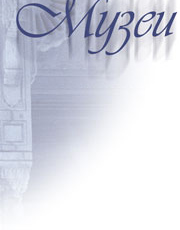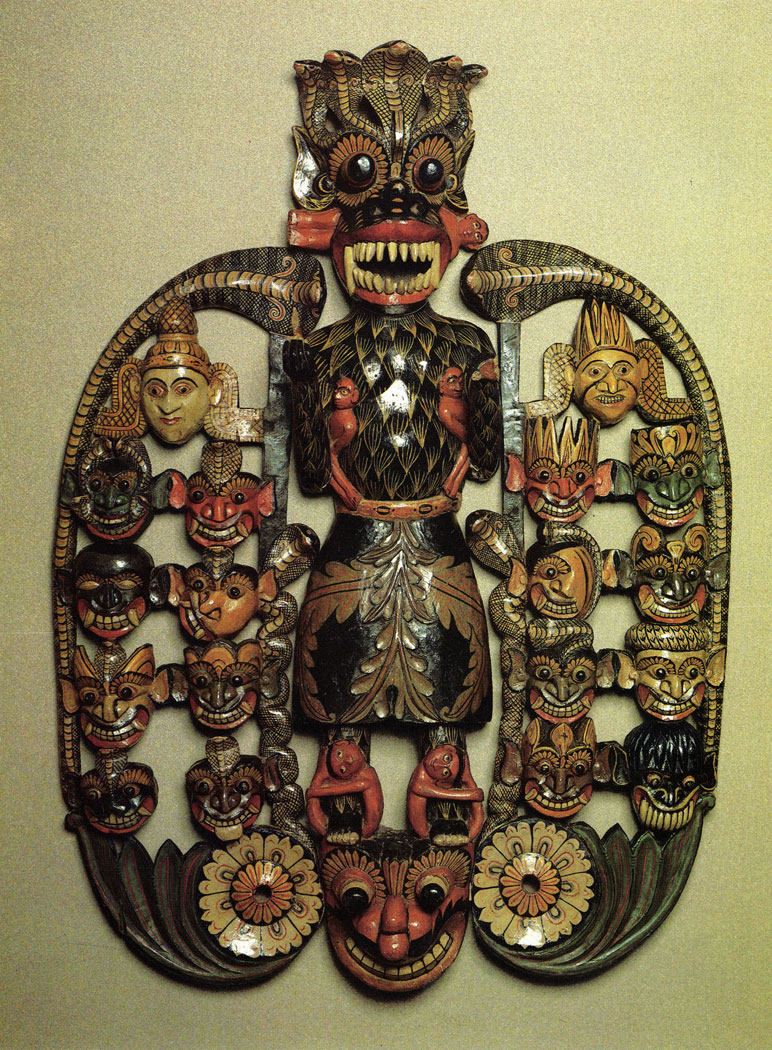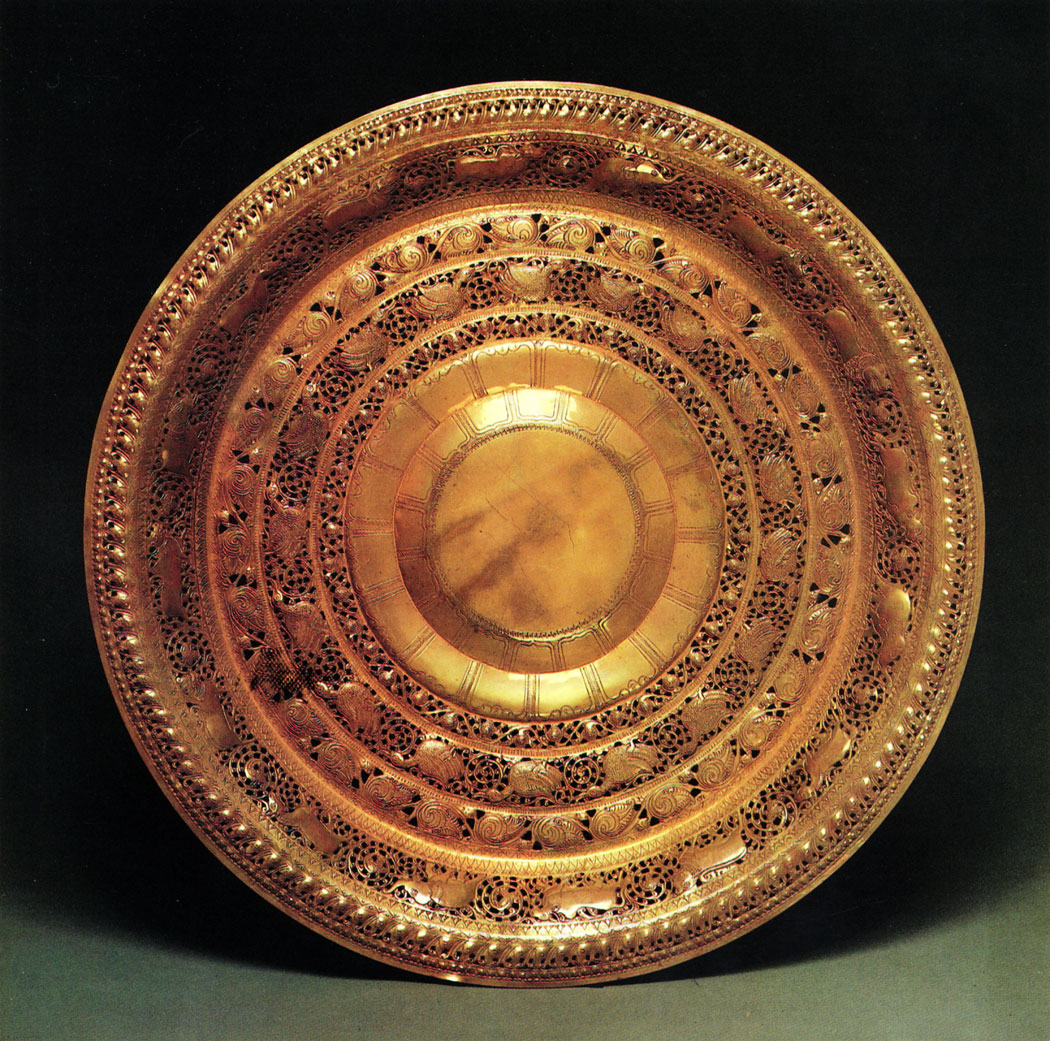
Sri Lanka

Maru Raksha mask
Sri Lanka. Early 20th century
Wood, carved and painted.
Height 108 cm. lnv. No.4486 II
Received in 1965 from the Museum of Toys, Zagorsk. First publication.
Masks appeared in Sri Lanka marty centuries ago, first as accessories to religious rites and then as attributes of folk games and dances. Mask-making is a hereditary craft; there are families in which this craft has been practised for several centuries. On both sides of the central figure, representing the demon of death Maru Raksha, there are compositions of 18 Sanni masks (9 on each side); these are images of demons inflicting various diseases. For example, Kora Sanni (the mask with a distorted face) personifies a paralitic; Biri Sanni, a deaf person (one part of his face is screened by a cobra, a symbol of deafness), etc.
Scene from The Tale of Prince Vesantara
By Piedas Guademana. Sri Lanka. 1950s
Painted cotton.
220 x 182 cm. lnv. No. 4126 II
Received in 1959 from the Board of Art Exhibitions and Panoramas attached to the USSR Ministry of Culture, Moscow.
According to the legend, in one of the regions of the country, Kalinga, a long period of drought caused a famine. The ruler of that province heard that Prince Vesantara possessed a white elephant which could bring rain. He sent his priests to the Prince to ask him for the elephant. The Prince gave them the elephant, but his compatriots, infuriated by his foolish act banished him and his wife Madri Devi and their children from the city. The exiles set out in their chariot to the woods, but soon they met two Brahmans who asked them for their horses. Vesantara gave the horses to the Brahmans and the family had to continue their way on foot. The episodes from the legend are represented in two identical tiers. The story is "narrated" from right to left, and the main characters are present in every scene, all the scenes being united in a single compositional pattern.
In its figural arrangement and rhythm the composition is reminiscent of temple wall-paintings.

Dish
Sri Lanka. 20th century
Chased copper.
Diameter 58.3 cm. lnv. No. 4130 II
Received in 1959 from the Board of Art Exhibitions and Panoramas attached to the USSR Ministry of Culture, Moscow. First publication.
This modern copper dish is no less refined or skilfully executed than its antecedents. The ornamentation is arranged in several concentric circles. One of the circular bands shows the alternating figures of an elephant, a horse, a lion and a bull; another band displays geese. All representations are shown against a delicate floral background. The origin of this type of ornamentation, called the moonstone motif, goes back to the 3rd or 4th century. At that time semi-circular stone slabs were placed at the entrances to some monasteries. They were decorated with carved representations of animals running one after another: an elephant, a horse, a lion and a bull. The choice of animals was not accidental and was inspired by Indian mythology. The animals symbolized the four parts of the world (the elephant for the east, the horse for the south, the lion for the north and the bull for the west). Besides, the bull, or Taurus, is a sign of the Zodiac under which the Buddha was born, and also the symbol of full moon; the lion symbolizes the Buddha himself, and so on. The centre of the moonstone motif was always a circle framed with lotus petals, the lotus-flower being the symbol of purity. Thus, the symbolic meaning of moonstone motifs is undoubtedly a reflection of the ancient peoples' notions of the universe. Nowadays this old motif is used mostly for decorative purposes, but the traditional elements are nevertheless accurately reproduced.
Fantastic Bird
By Vida Keineman. Sri Lanka. 1970s
Cotton, batik.
97 × 145cm. lnv. No. 25328 КП
Received in 1977 from the Vuchetich Art Workshops, Moscow.
Vida Keineman is active in various kinds of fine and decorative arts: painting, graphic art, ceramics, etc., but her popularity rests chiefly on her batiks. The batik method has been known in many countries in Africa and Asia, Sri Lanka among them, for centuries. Vida Keineman has made a notable contribution to the current development of the craft. Her batiks are quite traditional, but at the same time she freely uses the principles and devices of contemporary art. She produces original and in many ways unique pieces representing traditional themes as well as scenes of everyday life of peasants. She is also fond of animal motifs.
The panel Fantastic Bird is based on the traditional batik colours-blue, brown and olive. The composition bears a touch of originality and is treated in an attractively refined manner.
Family
By Vimalasari Deni. Sri Lanka. 1950s
Gouache on paper.
47.8 × 65 cm. lnv.No.3939 II
Received in 1958 from the Board of Art Exhibitions and Panoramas attached to the USSR Ministry of Culture, Moscow.
Vimalasari Deni was one of the most active participants of the Jataka Kala Peramuna movement, whose aim was to revive ancient artistic traditions in contemporary art. The artist's works present a wide panorama of the contemporary life of his country and its people and give a vivid picture of its exuberant nature.
The picture Family has a somewhat unusual compositional arrangement: each figure emerges from behind another, and the three of them form a monolithic group. The artist manages to create highly expressive images of common people; their figures impress us with their calm dignity and strength. The woman is treated with particular care: the artist evidently admires her almond-shaped eyes and her slender figure. The picture conveys the idea of Man's harmonious union with nature. The figures are placed against a background of large banana leaves. The expressive linear treatment and the restrained palette endow the picture with poetic charm.
|
ПОИСК:
|
© MUSEUMS.ARTYX.RU, 2001-2021
При использовании материалов сайта активная ссылка обязательна:
http://museums.artyx.ru/ 'Музеи мира'
При использовании материалов сайта активная ссылка обязательна:
http://museums.artyx.ru/ 'Музеи мира'